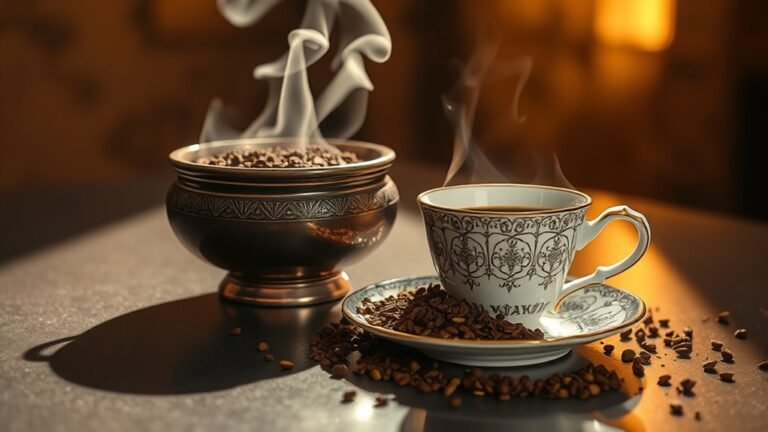Exploring Different Coffee Roasting Techniques
When exploring coffee roasting techniques, you’ll control time, temperature, airflow, and agitation to shape flavor profiles. Light roasts focus on preserving acidity and aromas with temperatures from 180°C to 205°C. Medium roasts balance sweetness and acidity through precise heat between 210°C and 221°C. Dark roasts use higher heat and longer durations, emphasizing smoky, bitter notes. Artisan approaches add small-batch precision, monitoring variables for nuanced results. Understanding these fundamentals equips you to tailor roasts expertly—there’s much more to uncover about optimizing each step.
Understanding the Basics of Coffee Roasting

Coffee roasting is a complex chemical process that transforms green coffee beans into the aromatic, flavorful beans used for brewing. You start with precise coffee bean selection, as the inherent qualities of the raw beans directly influence the final roast profile. Your choice impacts acidity, sweetness, and body, so you’ll want to source beans that align with your flavor goals. Next, you rely on roasting equipment designed to control temperature and airflow meticulously; common types include drum roasters and fluid bed roasters. These machines enable you to manipulate heat application, ensuring uniform development of the beans. Throughout roasting, monitoring time and temperature curves is essential, as they dictate Maillard reactions and caramelization stages. Mastering these fundamentals grants you the freedom to craft distinct, consistent roasts tailored to your preferences.
Light Roast Techniques and Their Flavor Profiles
When you roast coffee to a light level, you’ll preserve the bean’s original acidity and complex aromatic compounds. Techniques like the City and Cinnamon roasts require careful temperature control to avoid surpassing the first crack phase. Understanding these methods helps you highlight bright, fruity, and floral flavor profiles unique to light roasts.
Characteristics of Light Roasts
Light roasts preserve the inherent characteristics of the coffee bean by halting the roasting process shortly after the first crack, typically between 356°F and 401°F (180°C to 205°C). By stopping early, you retain a higher concentration of the bean’s original acids and sugars, which enhances flavor complexity. This approach emphasizes subtle fruity, floral, and citrus notes often lost in darker roasts. Aroma development is more nuanced, with brighter, fresher scents that reflect the bean’s terroir. Because the Maillard reaction is less advanced, you avoid the heavier caramelization and bitterness typical of longer roasts. When you choose light roasts, you embrace a purer expression of origin, allowing you to explore coffee’s diverse profiles with clarity and precision, revealing a more liberated tasting experience.
Popular Light Roasting Methods
Although roasting methods vary widely, those suited for lighter roasts focus on precise temperature control and careful timing to preserve the bean’s delicate acids and aromatic compounds. You’ll find that the light roast benefits include enhanced brightness and a complex flavor development rarely achieved in darker profiles. Here are popular light roasting methods and their impact on flavor:
| Method | Flavor Profile |
|---|---|
| Drum Roasting | Balanced acidity, nutty |
| Fluid Bed Roasting | Clean, bright, floral |
| Hot Air Roasting | Crisp, vibrant, fruity |
| Infrared Roasting | Smooth, nuanced, sweet |
Medium Roast Methods and Balanced Tastes

Since achieving a medium roast requires precise temperature control and timing, you’ll need to monitor the beans closely as they develop between 410°F and 430°F. This range is critical to reveal medium roast profiles that balance acidity and body without tipping into underdeveloped or overly dark flavors. You’ll want to focus on gradual heat application, allowing the Maillard reaction to progress steadily, preserving the nuanced brightness while initiating caramelization. Controlling airflow and drum speed guarantees even roasting, preventing scorching or uneven development. By mastering these variables, you maintain balanced acidity alongside moderate sweetness and complexity. This approach gives you freedom to craft coffee that’s versatile—suitable for diverse brewing methods and palates craving depth without overwhelming bitterness or sharpness. Medium roasts offer a midpoint that respects origin character and roasting precision.
Dark Roast Processes and Their Bold Characteristics
When you apply traditional dark roast methods, the beans undergo extended roasting times at higher temperatures, pushing them beyond the second crack stage. This process intensifies the coffee’s flavor profile, emphasizing smoky, bitter, and sometimes charred notes while reducing acidity. Understanding these precise changes helps you predict the bold characteristics unique to dark roasts.
Traditional Dark Roast Methods
Because traditional dark roast methods rely heavily on prolonged exposure to high temperatures, you’ll notice a distinct transformation in the coffee beans’ chemical structure and flavor profile. These traditional techniques emphasize deep roasting profiles, producing beans with oily surfaces and intensified smoky flavors. When using a French press, these robust characteristics shine, offering a full-bodied experience. Here’s what you should consider:
- Extended roasting duration at 230–240°C alters sugars and oils, enhancing bitterness.
- Constant agitation guarantees uniform heat exposure, preventing scorching.
- The Maillard reaction intensifies, contributing to complex smoky notes.
- Beans develop a glossy sheen due to surface oils releasing under heat.
Mastering these elements grants you freedom to craft bold, consistent dark roasts that honor traditional craftsmanship while catering to your palate.
Flavor Profiles and Intensity
Although dark roast processes push coffee beans to their limits, they reveal bold flavor profiles and intense characteristics that many enthusiasts seek. When you roast beans to this degree, chemical reactions like the Maillard reaction and caramelization dominate, creating deep, smoky, and sometimes bittersweet notes. You’ll notice intensity variations depending on factors such as roast duration and temperature control. Achieving ideal flavor balance can be challenging since prolonged roasting diminishes origin-specific nuances, favoring robust, uniform flavors instead. However, by precisely manipulating these variables, you can tailor the coffee’s intensity to your preference—whether it’s a bold, full-bodied cup or a slightly nuanced dark roast. Understanding these technical aspects empowers you to explore the full spectrum of dark roast profiles without sacrificing control or freedom in your brewing experience.
Specialty Roasting: Artisan and Small-Batch Approaches

How do artisan and small-batch roasting methods differ from traditional large-scale processes? When you embrace craft roasting, you gain control over intricate roasting profiles that highlight unique small batch flavors. Unlike mass production, artisan techniques allow you to:
- Precisely monitor bean temperature and airflow for nuanced development.
- Adjust roast curves to emphasize origin-specific characteristics.
- Limit batch sizes to maintain consistency and quality.
- Experiment with profile variations to reveal complex flavor layers.
This approach demands hands-on involvement and technical expertise, giving you the freedom to tailor each roast. You’re not just roasting coffee; you’re cultivating a distinct sensory experience. By prioritizing quality over quantity, you guarantee every batch expresses its full potential, enabling you to craft superior, personalized coffee that stands apart in a world of uniformity.
The Role of Roasting Time and Temperature Control
When you manage roasting time and temperature with exacting precision, you release the ability to manipulate chemical reactions that define coffee’s flavor profile. These roasting variables—time and temperature—act as your primary levers to control Maillard reactions, caramelization, and pyrolysis. Adjusting the temperature curve allows you to dictate how quickly sugars break down and how complex aromatic compounds evolve. Shorter roasting times at higher temperatures yield brighter acidity and lighter body, while extended times at moderate heat deepen bitterness and enhance body. You’ll find that subtle shifts in time-temperature interplay dramatically influence flavor development, enabling you to craft profiles from floral and fruity to rich and chocolatey. Mastering these variables grants you the freedom to access distinct characteristics tailored precisely to your desired taste.
Innovations in Coffee Roasting Technology
As coffee roasting technology advances, you gain access to tools that offer unprecedented control and consistency. Innovations in roasting automation and precision equipment empower you to refine every batch with exactitude. Here’s how these advancements serve your freedom to craft:
- Automated Profile Replication: Reproduce complex roast curves flawlessly, reducing variability.
- Real-Time Data Monitoring: Utilize sensors that track temperature, humidity, and airflow for immediate adjustments.
- Adaptive Algorithms: Machines learn and optimize roasting parameters based on bean origin and moisture content.
- Integrated Cooling Systems: Precisely control cooling rates to lock in desired flavor profiles.
Frequently Asked Questions
How Does Coffee Origin Affect Roasting Outcomes?
When you consider coffee origin, it directly shapes roasting outcomes because origin flavors vary widely. Each region’s unique soil, climate, and altitude create distinct regional profiles that influence how beans react during roasting. You’ll notice that lighter roasts highlight delicate floral or fruity notes specific to origin, while darker roasts can suppress those subtleties. Understanding these nuances lets you tailor roasting to preserve or enhance the coffee’s inherent character, giving you freedom to craft your perfect cup.
What Equipment Maintenance Is Essential for Consistent Roasting?
To guarantee consistent roasting, you’ve gotta prioritize grinder calibration regularly—it keeps particle size uniform, which affects extraction. Don’t skip machine cleaning either; residues and oils build up fast, altering heat transfer and flavor profiles. Clean roasting chamber surfaces, cooling trays, and chaff collectors meticulously. Regularly inspect and tighten parts to maintain peak airflow and temperature control. Staying precise with these maintenance steps gives you the freedom to produce reliable, high-quality roasts every time.
Can Roasting Impact Coffee’s Caffeine Content?
You might think roasting can drain all caffeine from your beans, but it’s not that extreme. While roast levels influence caffeine extraction subtly, darker roasts slightly reduce caffeine due to longer heat exposure. However, caffeine itself is quite stable during roasting. So, if you’re chasing maximum caffeine, focus more on grind size and brewing method rather than roast level. Roasting impacts flavor far more than caffeine content, giving you freedom to choose your perfect roast.
How Do Storage Conditions Affect Roasted Coffee Flavor?
When you store roasted coffee, controlling storage temperature is essential; too warm, and oils degrade, dulling flavor. You’ll want to keep humidity levels low to prevent moisture absorption, which can cause staling and off-flavors. Ideally, store coffee in an airtight container at a cool, consistent temperature away from light. By managing these factors, you preserve the coffee’s aromatic compounds and freshness, giving you the freedom to enjoy its full, vibrant flavor whenever you brew.
What Are Common Roasting Mistakes Beginners Make?
When you’re starting out, one common mistake is over roasting beans, which burns them and masks their unique flavors. Conversely, underdeveloped flavors happen if you stop roasting too soon, leaving beans grassy and sour. You’ll want to carefully control time and temperature to avoid these issues. Precision in your roast profile lets you reveal the coffee’s full potential, giving you freedom to craft a cup that truly expresses its origin and character.






